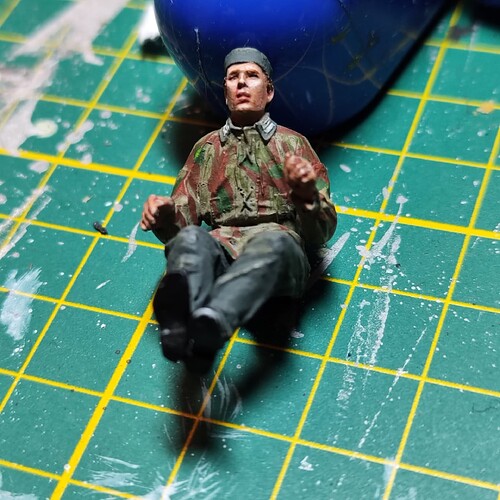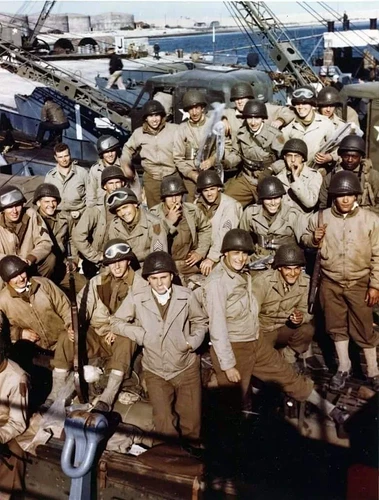I want to paint a couple of US tankers in HBT (early) uniform, in Tunesia. What I understand from this page, the colour I want to replicate was called OD8 (where I suppose OD stands for Olive Drab). MiniArt, interestingly enough states that the uniform parts should be painted what Vallejo calls London Grey (70.836)?
Does anyone know what the best base color is to simulate OD8?
Check Vallejo light green 71.225 or AK 137 olive drab shine.
Thanks… Those seem very light indeed…
Do you prime with a dark color or grey or start with white? If you start with white I would avoid using these shades, maybe something darker. If you go for the contrast approach (dark and white layer before basic color) I think both colors should work.
I can choose, as I have each color primer… The downside of using Vallejo Air is the lack of coverage when brush painted.
I am far from what you call “a decent figure painter” but I started following the instructions in the video and I have to admit I am improving
Yes, Vallejo Air is not the traditional brush paint. However if using the glazing method if might work better.
To provide contrast with the figures, you can do some with each primer color so they don’t look the same.
Figure looks fine, Erwin, keep er rollin. Color wise, close is always the desired, but don’t fret it too much if not dead on.
No, I know… but it must go a bit in the right direction… ![]()
But of course. I was more leaning towards the button counters that might be overly ambitious to direct your chosen color tones. That’s the beauty of oils for me, I can lean the shade in or out. ![]()
Don’t forget both the fading (wear and tear and laundering) that would happen with a uniform item made from 100% cotton as well as the minor variances in color due to dye lots and different manufacturers.
The uniform items would not look identical to each other in many cases. These items didn’t always fade at the same rate and you could find trousers and shirts of different levels of aging.
All this adds up to you having a wide range of possibilities in color. I always try to avoid using the same shade in a group setting.
BTW… I think the color designation for those later war uniform items was OD7.
Earlier colors were called “light shade” or some say OD5.
OD3 was the color name for M41 jackets and tanker jackets. These faded drastically.
I usually add some variation. Though I thus far only painted German uniforms in groupings, I add a bit of gray to the green base and vice versa… This creates variation.
According to the site I linked, the first edition was in OD8 while the later uniforms were in OD7. It states this explicitly…
“The actual government name for what is called “sage green” today was OD8. Yes, it and OD7 are out of sequential order.”
I read that at your link. I know At The Front. I also checked WWII Impressions. I never heard of OD8. The latter site mentioned OD5 (which I never heard of either. I always heard it described as “early war light shade, OD” No matter. You won’t find a paint labeled either OD8 or OD5.
My best recommendation is to use At The Front’s various photos of vintage clothing. They do a good job showing the very wide color spectrum for various uniform items. This also holds true for German WW2 “field gray” uniform items.
I do not claim to be all knowledgeable. If I lie, I lie in commission ![]()
I did not think I said you lied. If I came across that way it was not my intent.
As I said… I never heard of the OD8 mentioned by At The Front nor had I ever heard of OD5 mentioned by WWII Impressions.
Just to add to the confusion… US Army trousers were also issued in wool. They would be found in a wide variety of OD ranging from “mustard” to olive-brown. They were worn for both field and dress uses.
I don’t say that you called me a liar. I only ment to say that what I say, I read on the website and, that if that is incorrect, I can’t help it.
No offence meant or taken.
I doubt if the US army used woolen Uniforms in Tunisia.
I don’t have photo evidence to support the presence of wool in Tunisia. But it’s not a stretch. The wool pants were issued well before the US entered the war. Those clothing items would have come in handy in the chilly desert at night. We’ve all seen British 8th Army troops wearing wool coats.
I have no idea whether the US Army tanker overpants (bib-front) were made in an unlined as well as wool lined version but I do know they were worn in North Africa.
Both the M41 field jacket and tanker jacket were wool lined.
I just found this. The caption reads US troops North Africa November 1942.
https://www.reddit.com/r/wwiipics/comments/dbziwi/us_troops_in_north_africa_after_operation_torch/
A bit of digging turned up About WWII HBT Uniforms; below the first row of uniform images is the paragraph:
The Army introduced the Two-Piece herringbone-twill work suit in 1941 to replace the creaky denim pants and jumper. This uniform is referred to by collectors as the “first pattern HBT” and the color as “sage green” with both terms being contemporary and were not used by the US Army or QMC in WWII. The actual government name for what is called “sage green” today was OD8. Yes, it and OD7 are out of sequential order.
There are several images on the page contrasting uniform pieces in OD8 against OD7, so you can see at least one of the possible contrasts between the two colors. Once it got out into the field, and get washed several times, the shades may change.
Thanks, that is the same information I dug up… ![]()



